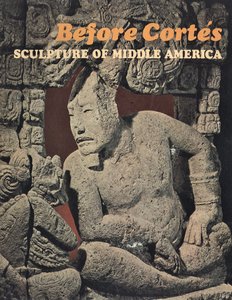Easby, Elizabeth Kennedy, & John F. Scott, "Before Cortés: Sculpture of Middle America"
Metropolitan Museum of Art/NY Graphic Society | 1970 | ISBN: N/A | English | PDF | 322 pages | 75.46 Mb
Metropolitan Museum of Art/NY Graphic Society | 1970 | ISBN: N/A | English | PDF | 322 pages | 75.46 Mb
The course of pre-Hispanic or, as it is frequently called, pre-Columbian art, has come full circle in our own twentieth century. It amazed the Spanish conquistadors four hundred fifty years ago, and, when first seen by European audiences, it evoked the spontaneous admiration and extravagant praise of such Renaissance figures as Dürer, Cellini, and Peter Martyr, an Italian cleric who wrote the first history of the New World. But all too soon it lapsed as art in Europe, to continue there merely as exotica in some princeling's Wunderkammer and still later in museums narrowly confined to ethnology and anthropology.
It is only in the United States that this art has been included in the collections of the most significant fine-arts museums and begun to be recognized by a few graduate schools of art and art history in our universities—a twentieth-century development of fairly limited acceptance. We at the Metropolitan are now proud to present it with other great art of the world.
Like the men of the Renaissance, the founding fathers of this Museum paid high tribute to the ancient art of the New World, which they felt was neither "savage" nor "barbarian," but showed "a cultivation of the love of beauty, measured by an independent standard which, however distinct from ours, nevertheless proves the presence of intellectual and art loving races of men." Some fine works were acquired and exhibited briefly, but the profound wisdom and farsightedness of the founding fathers were soon forgotten when most of these treasures were lent elsewhere (as anthropological or ethnographic material), and acquisition stopped. However, in the past two decades the pendulum has swung back, with international loan exhibitions from Colombia and Guatemala and the reciprocal loan agreement with Mexico, the great exhibition of masterpieces from The Museum of Primitive Art last year, the recent enrichment of our collections by important gifts from Mr. and Mrs. Nathan Cummings, Mrs. Harold L. Bache, and Mrs. Jacob Kaplan, and, of course, the truly notable agreement with the Honorable Nelson A. Rockefeller and The Museum of Primitive Art under which the superb collection of that museum will come to the Metropolitan in its entirety upon completion of the new wing to house it.
With the creation of a new Department of Primitive Art and the present exhibition we have not only come full circle but more than redeemed a pledge made in our Annual Report for 1883, wherein the President, John Taylor Johnston, stated: "The antiquities of our own continent should form a prominent feature in an American Museum, and we are charged with a special duty to make here a Museum of old American art for the study of American scholars as well as scholars from abroad."
Foreword
Advisory Committee
Lenders to the Exhibition
Preface
Relative Chronology of Middle America
Color Illustrations
1. High Cultures of Middle America
2. The Beginning of Sculpture
3. Olmec Leaders, Sculptors, and Lapidaries
4. Post-Olmec and Izapan Art
5. The Western Fringe
6. Urban Teotihuacán
7. Gulf Coast Sculpture in Clay and Stone
8. Zapotec Tombs and Offerings
9. The Maya Realm
10. The Wealth of the Indies
11. Toltec Imperial Art and its Heirs
12. The Aztecs: The Last Empire
Selected Reading List
Sources of Illustrations
Advisory Committee
Lenders to the Exhibition
Preface
Relative Chronology of Middle America
Color Illustrations
1. High Cultures of Middle America
2. The Beginning of Sculpture
3. Olmec Leaders, Sculptors, and Lapidaries
4. Post-Olmec and Izapan Art
5. The Western Fringe
6. Urban Teotihuacán
7. Gulf Coast Sculpture in Clay and Stone
8. Zapotec Tombs and Offerings
9. The Maya Realm
10. The Wealth of the Indies
11. Toltec Imperial Art and its Heirs
12. The Aztecs: The Last Empire
Selected Reading List
Sources of Illustrations





